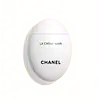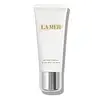What's inside
What's inside
 Key Ingredients
Key Ingredients

 Benefits
Benefits

 Concerns
Concerns

 Ingredients Side-by-side
Ingredients Side-by-side

Water
Skin ConditioningGlycerin
HumectantUndecane
EmollientCetearyl Alcohol
EmollientJojoba Esters
EmollientCetyl Alcohol
EmollientPentylene Glycol
Skin ConditioningTridecane
PerfumingCamellia Oleifera Seed Oil
Skin ConditioningEthyl Oleate
EmollientLauroyl Lysine
Skin ConditioningSodium Stearoyl Glutamate
CleansingIris Pallida Root Extract
MaskingFaex
Skin ConditioningCeramide NP
Skin ConditioningPhytosphingosine
Skin ConditioningCetearyl Glucoside
EmulsifyingDimethicone
EmollientEthyl Stearate
EmollientPropanediol
SolventChlorphenesin
AntimicrobialCaprylyl Glycol
EmollientParfum
MaskingCarbomer
Emulsion StabilisingXanthan Gum
EmulsifyingButyrospermum Parkii Butter Unsaponifiables
Skin ConditioningEthyl Linoleate
EmollientEthyl Palmitate
EmollientTocopherol
AntioxidantSodium Hyaluronate
HumectantSodium Hydroxide
BufferingPhytic Acid
1,2-Hexanediol
Skin ConditioningHydrogenated Lecithin
EmulsifyingSodium Citrate
BufferingSodium Benzoate
MaskingWater, Glycerin, Undecane, Cetearyl Alcohol, Jojoba Esters, Cetyl Alcohol, Pentylene Glycol, Tridecane, Camellia Oleifera Seed Oil, Ethyl Oleate, Lauroyl Lysine, Sodium Stearoyl Glutamate, Iris Pallida Root Extract, Faex, Ceramide NP, Phytosphingosine, Cetearyl Glucoside, Dimethicone, Ethyl Stearate, Propanediol, Chlorphenesin, Caprylyl Glycol, Parfum, Carbomer, Xanthan Gum, Butyrospermum Parkii Butter Unsaponifiables, Ethyl Linoleate, Ethyl Palmitate, Tocopherol, Sodium Hyaluronate, Sodium Hydroxide, Phytic Acid, 1,2-Hexanediol, Hydrogenated Lecithin, Sodium Citrate, Sodium Benzoate
Water
Skin ConditioningLimnanthes Alba Seed Oil
Skin ConditioningCaprylic/Capric Triglyceride
MaskingCetyl Alcohol
EmollientStearyl Alcohol
EmollientDimethicone
EmollientGlycerin
HumectantPentylene Glycol
Skin ConditioningGlyceryl Stearate
EmollientCoco-Caprylate/Caprate
EmollientAlgae Extract
EmollientSesamum Indicum Seed Oil
EmollientMedicago Sativa Seed Powder
Skin ConditioningHelianthus Annuus Seedcake
AbrasivePrunus Amygdalus Dulcis Seed Meal
AbrasiveEucalyptus Globulus Leaf Oil
PerfumingSodium Gluconate
Skin ConditioningCopper Gluconate
Skin ConditioningCalcium Gluconate
HumectantMagnesium Gluconate
Skin ConditioningZinc Gluconate
Skin ConditioningTocopheryl Succinate
AntioxidantNiacin
SmoothingSesamum Indicum Seed Powder
Skin ConditioningAspergillus Ferment
Skin ConditioningTriticum Vulgare Germ Extract
Skin ConditioningHordeum Distichon Extract
Skin ProtectingCrithmum Maritimum Extract
Skin ConditioningGinkgo Biloba Leaf Extract
Skin ConditioningMacadamia Integrifolia Seed Oil
Skin ConditioningGlyceryl Triacetyl Ricinoleate
EmollientYeast Extract
Skin ConditioningTourmaline
Sodium Hyaluronate
HumectantSqualane
EmollientTriethylhexanoin
MaskingLinoleic Acid
CleansingCholesterol
EmollientBisabolol
MaskingPantethine
EmollientCaffeine
Skin ConditioningCaprylyl Glycol
EmollientMethyl Glucose Sesquistearate
EmollientMagnesium Chloride
Sodium Sulfate
Calcium Chloride
AstringentPotassium Nitrate
SoothingPotassium Phosphate
BufferingXanthan Gum
EmulsifyingHexylene Glycol
EmulsifyingMagnesium Sulfate
PEG-100 Stearate
Parfum
MaskingLimonene
PerfumingLinalool
PerfumingHexyl Cinnamal
PerfumingAmyl Cinnamal
PerfumingBenzyl Benzoate
AntimicrobialCoumarin
PerfumingCitronellol
PerfumingTocopheryl Acetate
AntioxidantTocopheryl Nicotinate
AntioxidantDisodium EDTA
Sodium Hydroxide
BufferingPhenoxyethanol
PreservativeWater, Limnanthes Alba Seed Oil, Caprylic/Capric Triglyceride, Cetyl Alcohol, Stearyl Alcohol, Dimethicone, Glycerin, Pentylene Glycol, Glyceryl Stearate, Coco-Caprylate/Caprate, Algae Extract, Sesamum Indicum Seed Oil, Medicago Sativa Seed Powder, Helianthus Annuus Seedcake, Prunus Amygdalus Dulcis Seed Meal, Eucalyptus Globulus Leaf Oil, Sodium Gluconate, Copper Gluconate, Calcium Gluconate, Magnesium Gluconate, Zinc Gluconate, Tocopheryl Succinate, Niacin, Sesamum Indicum Seed Powder, Aspergillus Ferment, Triticum Vulgare Germ Extract, Hordeum Distichon Extract, Crithmum Maritimum Extract, Ginkgo Biloba Leaf Extract, Macadamia Integrifolia Seed Oil, Glyceryl Triacetyl Ricinoleate, Yeast Extract, Tourmaline, Sodium Hyaluronate, Squalane, Triethylhexanoin, Linoleic Acid, Cholesterol, Bisabolol, Pantethine, Caffeine, Caprylyl Glycol, Methyl Glucose Sesquistearate, Magnesium Chloride, Sodium Sulfate, Calcium Chloride, Potassium Nitrate, Potassium Phosphate, Xanthan Gum, Hexylene Glycol, Magnesium Sulfate, PEG-100 Stearate, Parfum, Limonene, Linalool, Hexyl Cinnamal, Amyl Cinnamal, Benzyl Benzoate, Coumarin, Citronellol, Tocopheryl Acetate, Tocopheryl Nicotinate, Disodium EDTA, Sodium Hydroxide, Phenoxyethanol
 Reviews
Reviews

Ingredients Explained
These ingredients are found in both products.
Ingredients higher up in an ingredient list are typically present in a larger amount.
Caprylyl Glycol is a humectant and emollient, meaning it attracts and preserves moisture.
It is a common ingredient in many products, especially those designed to hydrate skin. The primary benefits are retaining moisture, skin softening, and promoting a healthy skin barrier.
Though Caprylyl Glycol is an alcohol derived from fatty acids, it is not the kind that can dry out skin.
This ingredient is also used as a preservative to extend the life of products. It has slight antimicrobial properties.
Learn more about Caprylyl GlycolCetyl Alcohol is a fatty alcohol. Fatty Alcohols are most often used as an emollient or to thicken a product.
Its main roles are:
Though it has "alcohol" in the name, it is not related to denatured alcohol or ethyl alcohol.
The FDA allows products labeled "alcohol-free" to have fatty alcohols.
Learn more about Cetyl AlcoholDimethicone is a type of synthetic silicone created from natural materials such as quartz.
What it does:
Dimethicone comes in different viscosities:
Depending on the viscosity, dimethicone has different properties.
Ingredients lists don't always show which type is used, so we recommend reaching out to the brand if you have questions about the viscosity.
This ingredient is unlikely to cause irritation because it does not get absorbed into skin. However, people with silicone allergies should be careful about using this ingredient.
Note: Dimethicone may contribute to pilling. This is because it is not oil or water soluble, so pilling may occur when layered with products. When mixed with heavy oils in a formula, the outcome is also quite greasy.
Learn more about DimethiconeGlycerin is already naturally found in your skin. It helps moisturize and protect your skin.
A study from 2016 found glycerin to be more effective as a humectant than AHAs and hyaluronic acid.
As a humectant, it helps the skin stay hydrated by pulling moisture to your skin. The low molecular weight of glycerin allows it to pull moisture into the deeper layers of your skin.
Hydrated skin improves your skin barrier; Your skin barrier helps protect against irritants and bacteria.
Glycerin has also been found to have antimicrobial and antiviral properties. Due to these properties, glycerin is often used in wound and burn treatments.
In cosmetics, glycerin is usually derived from plants such as soybean or palm. However, it can also be sourced from animals, such as tallow or animal fat.
This ingredient is organic, colorless, odorless, and non-toxic.
Glycerin is the name for this ingredient in American English. British English uses Glycerol/Glycerine.
Learn more about GlycerinParfum is a catch-all term for an ingredient or more that is used to give a scent to products.
Also called "fragrance", this ingredient can be a blend of hundreds of chemicals or plant oils. This means every product with "fragrance" or "parfum" in the ingredients list is a different mixture.
For instance, Habanolide is a proprietary trade name for a specific aroma chemical. When used as a fragrance ingredient in cosmetics, most aroma chemicals fall under the broad labeling category of “FRAGRANCE” or “PARFUM” according to EU and US regulations.
The term 'parfum' or 'fragrance' is not regulated in many countries. In many cases, it is up to the brand to define this term.
For instance, many brands choose to label themselves as "fragrance-free" because they are not using synthetic fragrances. However, their products may still contain ingredients such as essential oils that are considered a fragrance by INCI standards.
One example is Calendula flower extract. Calendula is an essential oil that still imparts a scent or 'fragrance'.
Depending on the blend, the ingredients in the mixture can cause allergies and sensitivities on the skin. Some ingredients that are known EU allergens include linalool and citronellol.
Parfum can also be used to mask or cover an unpleasant scent.
The bottom line is: not all fragrances/parfum/ingredients are created equally. If you are worried about fragrances, we recommend taking a closer look at an ingredient. And of course, we always recommend speaking with a professional.
Learn more about ParfumPentylene glycol is typically used within a product to thicken it. It also adds a smooth, soft, and moisturizing feel to the product. It is naturally found in plants such as sugar beets.
The hydrophilic trait of Pentylene Glycol makes it a humectant. As a humectant, Pentylene Glycol helps draw moisture from the air to your skin. This can help keep your skin hydrated.
This property also makes Pentylene Glycol a great texture enhancer. It can also help thicken or stabilize a product.
Pentylene Glycol also acts as a mild preservative and helps to keep a product microbe-free.
Some people may experience mild eye and skin irritation from Pentylene Glycol. We always recommend speaking with a professional about using this ingredient in your routine.
Pentylene Glycol has a low molecular weight and is part of the 1,2-glycol family.
Learn more about Pentylene GlycolSodium Hyaluronate is hyaluronic acid's salt form. It is commonly derived from the sodium salt of hyaluronic acid.
Like hyaluronic acid, it is great at holding water and acts as a humectant. This makes it a great skin hydrating ingredient.
Sodium Hyaluronate is naturally occurring in our bodies and is mostly found in eye fluid and joints.
These are some other common types of Hyaluronic Acid:
Learn more about Sodium HyaluronateSodium Hydroxide is also known as lye or caustic soda. It is used to adjust the pH of products; many ingredients require a specific pH to be effective.
In small amounts, sodium hydroxide is considered safe to use. However, large amounts may cause chemical burns due to its high alkaline.
Your skin has a natural pH and acid mantle. This acid mantle helps prevent harmful bacteria from breaking through. The acid mantle also helps keep your skin hydrated.
"Alkaline" refers to a high pH level. A low pH level would be considered acidic.
Learn more about Sodium HydroxideWater. It's the most common cosmetic ingredient of all. You'll usually see it at the top of ingredient lists, meaning that it makes up the largest part of the product.
So why is it so popular? Water most often acts as a solvent - this means that it helps dissolve other ingredients into the formulation.
You'll also recognize water as that liquid we all need to stay alive. If you see this, drink a glass of water. Stay hydrated!
Learn more about WaterXanthan gum is used as a stabilizer and thickener within cosmetic products. It helps give products a sticky, thick feeling - preventing them from being too runny.
On the technical side of things, xanthan gum is a polysaccharide - a combination consisting of multiple sugar molecules bonded together.
Xanthan gum is a pretty common and great ingredient. It is a natural, non-toxic, non-irritating ingredient that is also commonly used in food products.
Learn more about Xanthan Gum